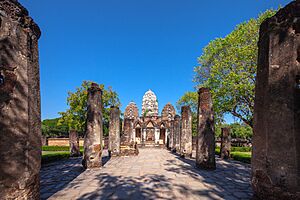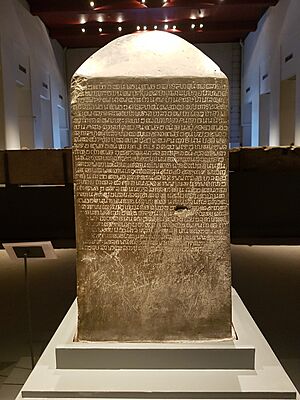Sukhothai Kingdom facts for kids
Quick facts for kids
Sukhothai Kingdom
อาณาจักรสุโขทัย
Anachak Sukhothai |
|||||||||
|---|---|---|---|---|---|---|---|---|---|
| 1238–1438 | |||||||||

Sukhothai Kingdom at its greatest extent during the late 13th century under the reign of King Ram Khamhaeng
|
|||||||||

Sukhothai Kingdom (orange) in 1400 CE
|
|||||||||
| Capital |
|
||||||||
| Common languages | Sukhothai | ||||||||
| Religion | Theravada Buddhism | ||||||||
| Government | Mandala kingship | ||||||||
| Monarch | |||||||||
|
• 1238–1270
|
Si Inthrathit (first) | ||||||||
|
• 1279–1298
|
Ram Khamhaeng | ||||||||
|
• 1347–1368
|
Li Thai | ||||||||
| Historical era | Post-classical era | ||||||||
|
• Establishment
|
1238 | ||||||||
| 1378–1438 | |||||||||
|
• Annexed to Ayutthaya
|
1438 | ||||||||
|
• Installation of Sanphet I
|
1569 | ||||||||
| Currency |
|
||||||||
|
|||||||||
| Today part of | |||||||||
The Sukhothai Kingdom (Thai: สุโขทัย, RTGS: Sukhothai) was an important kingdom in Mainland Southeast Asia. It was located in what is now north-central Thailand. The kingdom was started by Si Inthrathit in 1238. It was an independent country until 1438. After that, it became part of the powerful Ayutthaya Kingdom.
Sukhothai was first a trading town within the Lavo Kingdom. Lavo was under the control of the Khmer Empire. But then, local Thai people led by Pho Khun Bang Klang Hao rebelled. They won their freedom. Bang Klang Hao became the first king of Sukhothai. He took the royal name Si Inthrathit. This started the Phra Ruang dynasty.
The kingdom grew strongest under King Ram Khamhaeng the Great (1279–1298). Some historians believe he brought Theravada Buddhism to the kingdom. He also helped create the Sukhothai script, which was an early form of the Thai writing system. Ram Khamhaeng also started trade with Yuan China. This led to Sukhothai making and selling beautiful ceramics called sangkhalok ware.
After Ram Khamhaeng's rule, the kingdom became weaker. In 1349, during the reign of King Li Thai, the Ayutthaya Kingdom invaded Sukhothai. Sukhothai then became a "tributary state." This means it had to pay tribute to Ayutthaya. Sukhothai was fully taken over by Ayutthaya in 1438. This happened after the death of King Borommapan. Even after this, Sukhothai's noble families still had influence in the Ayutthaya monarchy for many years.
Sukhothai is often called "the first Thai kingdom" in Thai history books. However, historians now agree that the history of the Thai people began much earlier. The old capital city of Sukhothai is now a World Heritage Site. Its ruins are preserved as the Sukhothai Historical Park. It is about 12 kilometers from the modern town of Sukhothai Thani.
Contents
What Does Sukhothai Mean?
The name Sukhothai (Thai: สุโขทัย) comes from a Thai word. This word came from the Khmer word Sukhodaya. The Khmer word itself came from two Sanskrit words: sukha (meaning 'lasting happiness') and udaya (meaning 'rise' or 'emergence'). So, together, Sukhothai can mean "dawn of happiness."
History of Sukhothai
How Sukhothai Began
Sukhothai was first a town around the year 1200. It was under the control of the Lavo Kingdom. Many monuments were built in the city during this time. Some of these, like Wat Phra Phai Luang and Wat Si Sawai, can still be seen today in the Sukhothai Historical Park.
In 1238, a local leader named Pho Khun Bang Klang Hao led a rebellion. He and his allies fought against the governor in Sukhothai. They won and made Sukhothai an independent Thai state. This was a very important moment for the Tai people. Sukhothai became a major center of power for them.
Bang Klang Hao became the first ruler of Sukhothai. He was known as King Si Inthrathit. He started the Phra Ruang dynasty. Under his rule, the kingdom grew. By the time he died in 1270, Sukhothai controlled the upper valley of the Chao Phraya River.
Growth Under King Ram Khamhaeng

After King Si Inthrathit, his son Ban Mueang ruled. Then, Ban Mueang's brother, Ram Khamhaeng the Great, became king in 1279. Both kings helped Sukhothai grow even larger.
King Ram Khamhaeng expanded the kingdom to the south. He took control of areas like Suvarnabhumi and Tambralinga. It is said that through Tambralinga, he brought Theravada Buddhism to Sukhothai as the main religion.
To the north, Ram Khamhaeng made cities like Phrae and Muang Sua (now Luang Prabang, Laos) pay tribute to Sukhothai. To the west, he helped the Mon people fight against the Pagan Empire. This led to the creation of a new kingdom at Martaban (now Bago, Myanmar).
King Ram Khamhaeng also invited monks from Sri Thamnakorn to spread Theravada Buddhism in Sukhothai. In 1283, he likely created the Sukhothai script. This was an early form of Thai writing. The oldest example of this writing is on the Ram Khamhaeng Inscription. This important stone was found much later by King Mongkut (Rama IV). The Sukhothai script later developed into the modern Thai script we use today.
During Ram Khamhaeng's time, Sukhothai also started trading with Yuan China. Sukhothai became famous for its sangkhalok ware. These were special Chinese-style ceramics made in Siam.
Decline and Becoming a Tributary State
After King Ram Khamhaeng died, his son Loe Thai became king. But soon, the areas that Sukhothai controlled began to break away.
- To the north, Lao kingdoms like Muang Sua and Vieng Chan Vieng Kham (now Vientiane) became independent.
- To the west, Martaban broke away in 1319.
- In 1321, Lan Na took over Tak, an old Sukhothai town.
- To the south, Suphan Buri also became free.
This meant Sukhothai quickly became a smaller, local power again.
In 1347, Li Thai became king. In 1349, armies from the Ayutthaya Kingdom invaded Sukhothai. Sukhothai was forced to become a "tributary state" of Ayutthaya. This meant Sukhothai had to accept Ayutthaya's rule and pay them tribute. The main center of power in Sukhothai moved to Song Khwae (now Phitsanulok).
In 1378, King Lue Thai also had to submit to Ayutthaya. When King Sai Lue Thai died in 1424, his sons fought for the throne. King Intharacha of Ayutthaya stepped in. He made one of the sons, Borommapan (King Maha Thammaracha IV), the new king.
When Borommapan died in 1438, Ayutthaya's King Borommarachathirat II sent his own son, Ramesuan, to rule Sukhothai. Ramesuan became like a viceroy, or a special governor. This officially ended Sukhothai as an independent kingdom.
Sukhothai's Lasting Influence
Even after Sukhothai became part of Ayutthaya, its former lands were still important. They were called "mueang nuea" (meaning 'northern cities'). Local nobles still ruled these areas under Ayutthaya's control. Over time, the cultures of Sukhothai and Ayutthaya blended together. Sukhothai's ways of fighting wars, its government, architecture, religion, and language all influenced Ayutthaya.
Sukhothai's noble families also married into Ayutthaya's royal family. They often helped decide who would become the next king of Ayutthaya. Sukhothai's military leaders were known for being tough. They served important roles in Ayutthaya's army. Some Portuguese traders even called Ayutthaya and Sukhothai "twin states."
From 1456 to 1474, the old Sukhothai area became a battlefield during the Ayutthaya-Lan Na War. In 1462, Sukhothai briefly rebelled against Ayutthaya. It joined forces with Ayutthaya's enemy, Lan Na. In 1463, Ayutthaya's King Borommatrailokkanat even moved his home to Song Khwae (Phitsanulok). This was to be closer to the fighting. The city was then permanently renamed Phitsanulok.
In 1548, a noble from the Sukhothai family, Khun Phirenthorathep, was made leader in Phitsanulok. He was given the name Maha Thammaracha. This name was used by the historical kings of Sukhothai. He also married one of Ayutthaya's king's daughters. This made his claim to power even stronger.
Later, Maha Thammaracha joined forces with the Burmese against Ayutthaya. In 1569, Ayutthaya fell to the Burmese. The Burmese king then made Maha Thammaracha the new king of Ayutthaya. This started the Sukhothai dynasty in Ayutthaya.
In 1584, Maha Thammaracha and his son, Naresuan the Great, freed Ayutthaya from Burmese rule. After a major battle, Naresuan moved people from the northern cities, including Sukhothai, closer to Ayutthaya. Since then, the ruins of the old Sukhothai capital have been preserved. They are now the Sukhothai Historical Park and a World Heritage Site.
What Sukhothai Left Behind
The Silajaruek of Sukhothai are hundreds of stone inscriptions. They are like historical records from that time. The most important one is the Ram Khamhaeng Inscription (also called Inscription No. 1). It tells us a lot about the kingdom's history.
King Mongkut (Rama IV) is famous for discovering Inscription No. 1. He said it was the "first evidence" of Sukhothai's history. This inscription told stories of brave kings like Ram Khamhaeng. It also described the government system and other good things from what was called the "prosperous time" of the kingdom. The story of Sukhothai became a key part of Thailand's "national history" in the late 1800s.
From then on, the history of the Sukhothai Kingdom was included in modern Siamese history. Sukhothai was called the "first national capital." It was followed by Ayutthaya, then Thonburi, and finally Rattanakosin (today's Bangkok). Sukhothai's history was very important to those who wanted to modernize Siam.
One popular idea was that Sukhothai had a "democracy-like" rule. Stories described a close relationship between the king and his people, like a "father-son" bond. This was seen as the beginning of ancient Thai democracy. Some believed that later, society changed because of "foreign" traditions, like those from Angkor. These were influenced by Hinduism and a different kind of Buddhism. The story of Sukhothai became a symbol of "freedom."
See also
- Mandala (political model)
- List of Thai monarchs




